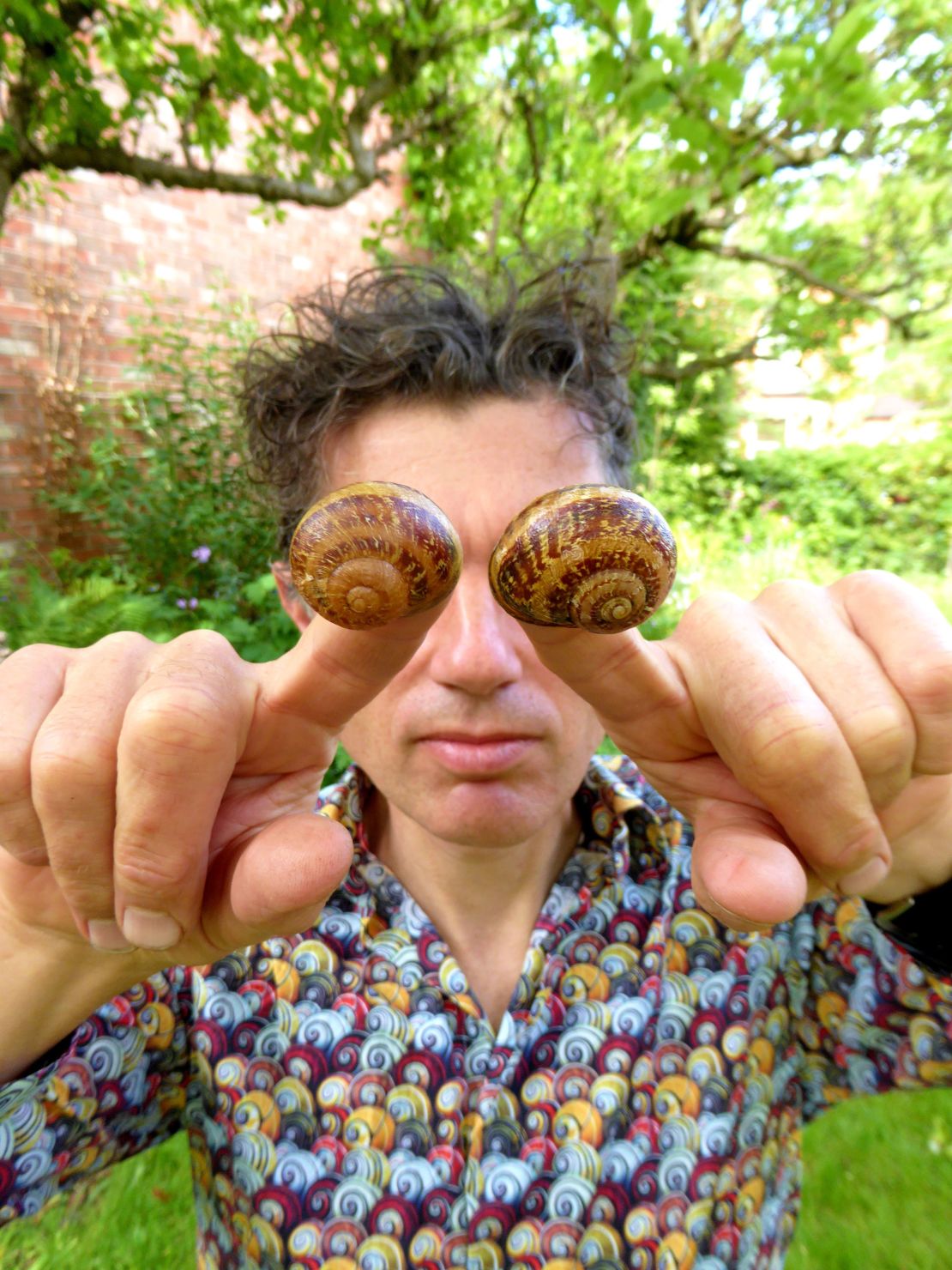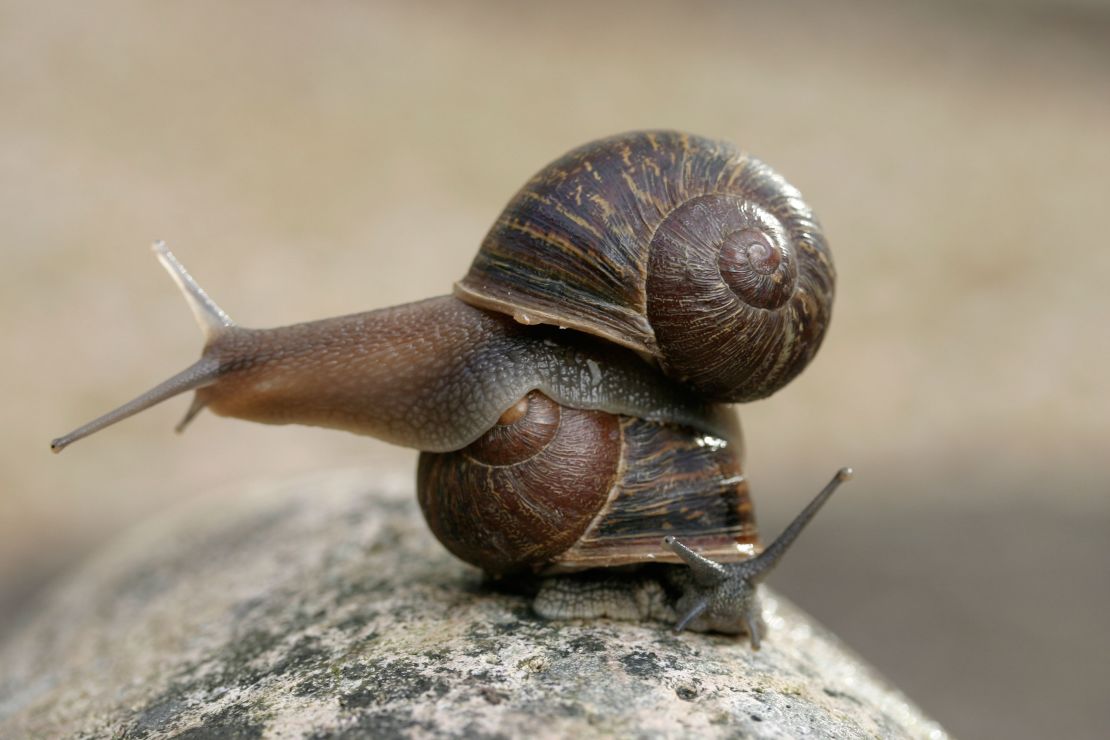A scientific journey that began with a lovelorn snail has provided new information regarding the cause of that snail’s rare shell.
The lovesick gastropod was a garden snail called Jeremy, named after the reportedly garden-loving, left-wing UK politician Jeremy Corbyn, according to a study published Tuesday in the journal Biology Letters.
Jeremy was rare for the direction in which its shell coiled. The asymmetrical appearance of a snail’s shell due to its coiled structure is an example of what’s called chirality.
Jeremy was a lefty, but that’s not a political statement.
Its shell coiled counterclockwise to the left instead of the right, which made Jeremy a sinistral snail. Some snails naturally vary in their shell coils, but sinistral snails are incredibly rare in most snail species.
The rarity of sinistral garden snails makes studying them difficult, rendering the developmental and genetic background of their oddity mysterious.
Lefty snails have mirror-imaged bodies when compared to common, dextral (righty) snails, so their genitals are on the left side. This makes mating challenging, said Angus Davison, the study’s first author and an associate professor in evolutionary genetics at the University of Nottingham in England.
Their difficulty mating with righty snails contributes to their rarity, as they won’t pass on any genes for being a lefty if they don’t mate, Davison added. It’s also difficult to change the genes that determine asymmetry without also causing developmental problems.

To be able to study whether their lefty coils are genetically inherited, “you have to get two lefties in the same place,” he said.
So Davison could learn more, Jeremy starred in a 2016 internet campaign to recruit citizen scientists to find a mate for Jeremy and other sinistral snails.
The campaign, leading with #snaillove, became globally popular in scientific circles and among the public. A keen-eyed group of citizen scientists and farmers found more than 40 lefty snails in the wild and on snail farms in America, Australia and Europe, where garden snails are native.
The snails traveled by snail mail and train to the lab at the University of Nottingham. Then, a three-generation breeding program found the rare left-spiraling shell of some garden snails was likely often a developmental accident, rather than an inherited condition.
Finding Jeremy, the rare lefty snail
Common snails are usually left-right asymmetric both inside and outside, which is obvious in the way their shell coils to the right, the study said.
In previous studies, sinistrality was considered to be possibly a developmental issue. It was also possible that the counterclockwise coiling of a shell may have resulted from a disease caused by a gene mutation.
Davison had been studying the genetics of asymmetry and snails for about 20 years when a colleague from the Natural History Museum of London alerted him that he’d found a lefty garden snail.
The year was 2016, and the snail was Jeremy.
“I’d received this snail and I’d never seen one; it was amazing, super rare,” Davison said. “But the problem was, what can I do with it? Because it can’t mate with other snails.”
He turned to the internet campaign, hoping to use Jeremy’s potential offspring to study the genetics of sinistral snails.
Initially, two potential suitors rejected Jeremy. But shortly before Jeremy’s death in 2017, one mate produced 56 babies, about a third of which were likely to be “fathered” by Jeremy (the study author’s choice of words).
The breeding program
Davison and the scientists bred the lefty snails together, and over three years, nearly 15,000 eggs were hatched from four generations of snails, including Jeremy.
“We needed to breed them together to make individuals that might have two versions of a ‘lefty’ gene,” Davison said. “These individuals would give birth to eggs which then hatch into sinistrals. The easiest way to do this is to mate siblings together (to inbreed them).”
The reason why they had to breed snails over a few generations was because the gene could have been recessive and because it usually has a delayed effect, Davison said.
“In the same way the colour of an egg shell is due to a gene in the mother, then direction of twist in snail shell is usually due to a gene in the mother — [a] so-called ‘maternal effect’ or ‘maternal inheritance,’” Davison explained.
In almost all groups of the sinistral snails, none of the pairs produced sinistral offspring, only common dextral snails (righties).
There was one exception — when coauthor and citizen scientist Philippe Thomas mated second-generation dextral offspring of French sinistral garden snails. Six of 32 dextral snails produced 17 sinistral offspring out of 6,302 total offspring. The proportion of sinistrals in the righty snails that produced any sinistrals at all was 1.7%.
The finding highlighted a “partially penetrant recessive sinistral gene” in each of the original parents. This meant that the newborn French sinistrals carried two copies of a recessive gene, which increased a tendency to produce lefties but was delayed in expression.
“So rather than kind of an oddball switch, it’s like a dial [that just] dials up a little bit so you just get a few sinistrals,” Davison said.
If the finding had resulted from a disease caused by a genetic mutation, all of the French offspring would have been sinistral instead of just some of them, he said.

Because the authors didn’t breed any other sinistrals and the French sinistral offspring were such a rare exception, the authors concluded sinistrals to be more often the result of developmental aberrations rather than genetic inheritance.
As cells divide in early stages of development, snails’ shells usually turn clockwise. What makes a reverse, lefty snail is when the coil twists the other way.
“It could be all kinds of things that just by chance reverse that,” Davison said, whether the reasons are environmental, chemical or more.
“Though the outcomes of nearly all the many matings are dextral snails — indicating a non-genetic cause and not particularly interesting — the finding of a potential non-penetrant gene responsible for rare sinistral offspring in French garden snails is interesting,” said Reiko Kuroda, a professor in the Frontier Research Institute at Chubu University in Japan. Kuroda also studies genetics of asymmetry in snails, but was not involved in Davison’s study.
The researchers are still collecting DNA from the French sinistral snails in hopes of mapping the gene once the pandemic is over — during which the remaining snails are being kept alive and fed.
“We have learned that two lefties usually make a right, at least if you are a garden snail. In other snails, being a lefty is an inherited condition, but we still don’t really know how they do it,” Davison said in a press release. “If we are able to find out, then this may help us understand how the right and left side of other animal bodies are defined, including ourselves.”





